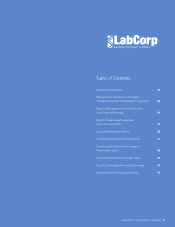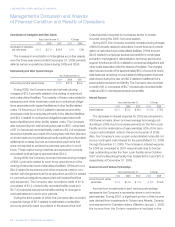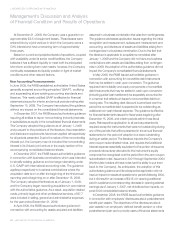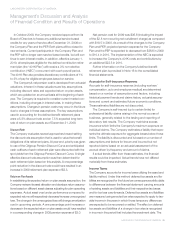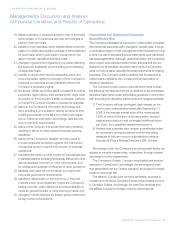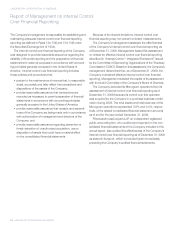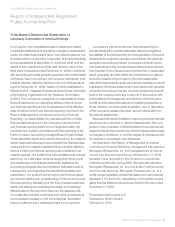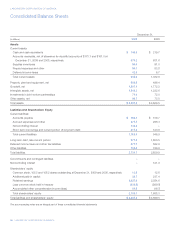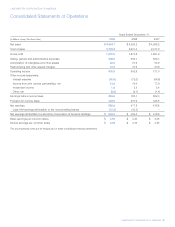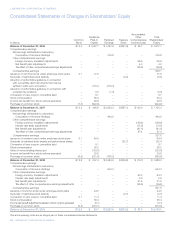LabCorp 2009 Annual Report Download - page 30
Download and view the complete annual report
Please find page 30 of the 2009 LabCorp annual report below. You can navigate through the pages in the report by either clicking on the pages listed below, or by using the keyword search tool below to find specific information within the annual report.LABORATORY CORPORATION OF AMERICA
Management’s Discussion and Analysis
of Financial Condition and Results of Operations
28 LABORATORY CORPORATION OF AMERICA
At December 31, 2009, the Company was a guarantor on
approximately $2.5 of equipment leases. These leases were
entered into by a joint venture in which the Company owns a
50% interest and have a remaining term of approximately
three years.
Based on current and projected levels of operations, coupled
with availability under its senior credit facilities, the Company
believes it has sufficient liquidity to meet both its anticipated
short-term and long-term cash needs; however, the Company
continually reassesses its liquidity position in light of market
conditions and other relevant factors.
New Accounting Pronouncements
In June 2009, the FASB established authoritative United States
generally accepted accounting principles (“GAAP”), codifying
and superseding all pre-existing accounting standards and
literature. This newly codified GAAP is effective for financial
statements issued for interim and annual periods ending after
September 15, 2009. The Company has adopted the guidance
without any impact on the consolidated financial statements.
In December 2007, the FASB issued authoritative guidance
requiring all entities to report noncontrolling (minority) interests
in subsidiaries as equity in the consolidated financial statements.
The Company adopted the guidance as of January 1, 2009
and pursuant to the provisions of the literature, the presentation
and disclosure requirements have been applied retrospectively
for all periods presented. Due to the nature of the noncontrolling
interest put, the Company has not included the noncontrolling
interest in its Ontario joint venture in the equity section of the
accompanying consolidated balance sheets.
In December 2007, the FASB issued authoritative guidance
in connection with business combinations which was intended
to simplify existing guidance and converge rulemaking under
U.S. GAAP with international accounting rules. The guidance
applies prospectively to business combinations where the
acquisition date is on or after the beginning of the first annual
reporting period beginning on or after December 15, 2008.
The Company adopted the literature as of January 1, 2009,
and the Company began recording acquisitions in accordance
with the authoritative guidance. As a result, acquisition related
costs, primarily legal and other professional services, of $7.7
were included in selling, general and administrative expenses
for the year ended December 31, 2009.
In April 2009, the FASB issued authoritative guidance in
connection with accounting for assets acquired and liabilities
assumed in a business combination that arise from contingencies.
The guidance addresses application issues regarding the initial
recognition and measurement, subsequent measurement and
accounting, and disclosure of assets and liabilities arising from
contingencies in a business combination. Due to the fact that
the literature is applicable to acquisitions completed after
January 1, 2009 and the Company did not have any business
combinations with assets and liabilities arising from contingen-
cies in 2009, the adoption of the authoritative guidance did not
impact the Company’s consolidated financial statements.
In May 2008, the FASB issued authoritative guidance in
connection with accounting for convertible debt instruments
that may be settled in cash upon conversion. The guidance
requires that the liability and equity components of convertible
debt instruments that may be settled in cash upon conversion
(including partial cash settlement) be separately accounted for
in a manner that reflects an issuer’s nonconvertible debt bor-
rowing rate. The resulting debt discount is amortized over the
period the convertible debt is expected to be outstanding as
additional non-cash interest expense. The guidance is effective
for financial statements issued for fiscal years beginning after
December 15, 2008, and interim periods within those fiscal
years. Retrospective application to all periods presented is
required except for instruments that were not outstanding during
any of the periods that will be presented in the annual financial
statements for the period of adoption but were outstanding
during an earlier period. The literature impacts the Company’s
zero-coupon subordinated notes, and requires that additional
interest expense essentially equivalent to the portion of issuance
proceeds retroactively allocated to the instrument’s equity
component be recognized over the period from the zero-coupon
subordinated notes’ issuance in 2001 through September 2004
(the first date holders of these notes had the ability to put them
back to the Company). As anticipated, the adoption of this
authoritative guidance and its retrospective application did not
have an impact on results of operations for periods following 2004,
but it did result in an increase of $215.4 in opening additional
paid-in capital and a corresponding decrease in opening retained
earnings as of January 1, 2007, net of deferred tax impacts, on
post-2004 consolidated balance sheets.
In December 2008, the FASB issued authoritative guidance
in connection with employers’ disclosures about postretirement
benefit plan assets. The objectives of the disclosures about
plan assets in an employers’ defined benefit pension or other
postretirement plan are to provide users of financial statements



